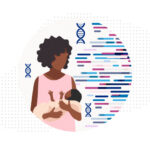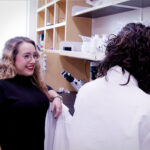A global take on rare disease research: Maya Chopra, MBBS, FRACP

Several years ago, while working as a clinical geneticist at the Imagine Institute of Genetic Diseases in Paris, Dr. Maya Chopra saw a child with unexplained intellectual disability, a cleft palate, distinctive facial features, and an inability to speak. Through a genetic analysis, she and her colleagues identified a rare variant in one copy of a gene called ANKRD17.
Intrigued, Dr. Chopra asked around about other cases. Today, she co-leads an international collaboration that has now described more than 30 individuals with rare ANKRD17 variants. The condition, a rare neurodevelopmental disorder, has been named for her: Chopra-Amiel-Gordon Syndrome. She now fields inquiries from physicians, labs, and families with the condition from around the world.
It’s just one of many conditions she has encountered in her 16 years of practice. Training and working in Australia, China, France, and now at Boston Children’s Hospital, Dr. Chopra has navigated many different health care settings.
“Despite cultural and economic differences, families of children with rare diagnoses want to know the same things,” she says. “What does this diagnosis mean? What is going to happen in the future? What is the pathway to treatment? Their questions drive my research.”
Characterizing a rare neurodevelopmental disorder
Early in Dr. Chopra’s career, physicians could only diagnose genetic conditions about 30 percent of the time. They had to make an educated guess of what genes or groups of genes might be involved and test those for mutations. Today, the ability to test the entire genome or exome (all the genes that code for proteins) has increased the rate of diagnosis to about 50 percent.
As additional people with a given rare disease are identified, physician-scientists like Dr. Chopra can conduct research to better understand the condition’s features and help newly diagnosed families know what to anticipate. Ultimately, the goal is develop targeted treatments.
Despite cultural and economic differences, families of children with rare diagnoses want to know the same things: What does this diagnosis mean? What is going to happen in the future? What is the pathway to treatment?
Now director of Translational Genomic Medicine for the Rosamund Stone Zander Translational Neuroscience Center (RSZ-TMC) at Boston Children’s, she is delving deeply into Chopra-Amiel-Gordon Syndrome. Collecting tissue samples from interested families and partnering with the Human Neuron Core, she is studying brain cells derived from these samples, exploring what these cells look like, how they send messages, and how they form connections as compared with healthy cells.
She hopes this will shed light on how the brains of people with Chopra-Amiel-Gordon Syndrome differ from those of healthy individuals. “We have looked at their brain MRIs, but there’s nothing really telling,” she explains.
National and global collaborations drive progress
The genomics revolution has uncovered more and more rare genetic disorders — more than 7,000 to date. Many of these could potentially be treated with gene therapy. Because developing and testing gene therapies is a complex, multi-year process, Dr. Chopra realized there needed to be a way to set priorities. She and her colleagues at the RSZ-TNC developed a framework called GENE TARGET that takes into account multiple factors, including medical and ethical considerations.
Understanding the relationship between genes, brain development, and rare brain disorders is often a collective endeavor. Dr. Chopra collaborates with national networks like the Intellectual and Developmental Disabilities Research Center and the National Brain Gene Registry, where she is Genome Medicine lead, and is plugged into various international groups and rare disease communities.
“Outreach, collaboration and communication are so important for rare disease research,” says Dr. Chopra. “We need to deeply engage with families and advocates, and we must ensure that our research is representative of the global population. As we learn from each other, we can advance the whole field forward.”
Read more profiles of Boston Children’s researchers.
Related Posts :
-

Cracking the code on Kleefstra syndrome: It takes a community
Paul Terry is a staunch advocate for people with rare diseases — but researchers were only able to put a name ...
-

Rapid DNA sequencing yields timely answers for infant epilepsy
Treating children with epilepsy has traditionally been a matter of trial and error, trying different drugs one after the other. ...
-

The clot thickens: Kellie Machlus, PhD
Part of an ongoing series profiling researchers at Boston Children’s Hospital. Platelets are the bandages of our blood, forming ...
-

Perfecting the craft of modeling disease in stem cells: Dosh Whye
Part of an ongoing series profiling researchers at Boston Children’s Hospital. Dosh Whye has always wanted to make peoples’ ...





